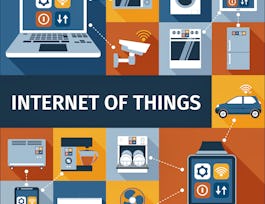This course is the last course in our series of four courses and builds on the previous three courses: IoT Devices, IoT Communications, and IoT Networking. After we have built and programmed a small self-driving vehicle, we then set out to enhance its connectivity and add important security infrastructure. In this course we will now look closer into various remaining types of decentralized network topography. In the lab, we will additionally cover important cloud technologies based on machine-learning. In the first two weeks' lectures, we will cover important components of networks. Metaphorically speaking, when you learn how the human body works, you start by understanding the "organs", the stomach, the liver, and so on. Likewise, we can best understand networks by understanding the individual components that make them up and their function. In this lecture series we will study "devices" such as routers, switches, firewalls, load balancers, and many more. We will learn about how they individually operate, how they are configured, and how they work together to achieve various network-wide properties and goals.



IoT Cloud
This course is part of Hands-on Internet of Things Specialization

Instructor: Matthew Caesar
Sponsored by Coursera Learning Team
4,364 already enrolled
(27 reviews)
Recommended experience
Skills you'll gain
- Infrastructure Architecture
- Computer Hardware
- Network Engineering
- Computer Networking
- Internet Of Things
- Network Planning And Design
- General Networking
- Artificial Intelligence
- Information Technology Operations
- IT Infrastructure
- Electronic Hardware
- Network Architecture
- Machine Learning
- Networking Hardware
- Network Infrastructure
- Artificial Intelligence and Machine Learning (AI/ML)
- Network Administration
- Computer Science
Details to know

Add to your LinkedIn profile
6 assignments
See how employees at top companies are mastering in-demand skills

Build your subject-matter expertise
- Learn new concepts from industry experts
- Gain a foundational understanding of a subject or tool
- Develop job-relevant skills with hands-on projects
- Earn a shareable career certificate


Earn a career certificate
Add this credential to your LinkedIn profile, resume, or CV
Share it on social media and in your performance review

There are 4 modules in this course
You almost made it! This course is the last course in our series of four courses and builds on the previous three courses: IoT Devices, IoT Communications, and IoT Networking. After we have built and programmed a small self-driving vehicle, we then set out to enhance its connectivity and add important security infrastructure. In this course we will now look closer into various remaining types of decentralized network topography. In the honors lab (which we strongly recommend), we will additionally cover important cloud technologies based on machine-learning. In the first two weeks' lectures, we will cover important components of networks. Metaphorically speaking, when you learn how the human body works, you start by understanding the "organs", the stomach, the liver, and so on. Likewise, we can best understand networks by understanding the individual components that make them up and their function. In this lecture series we will study "devices" such as routers, switches, firewalls, load balancers, and many more. We will learn about how they individually operate, how they are configured, and how they work together to achieve various network-wide properties and goals.
What's included
5 videos7 readings1 assignment1 discussion prompt
This week, we continue to explore further the topic of week 1. Please be aware that the quiz of this week will cover both week 1 and 2.
What's included
4 videos1 reading2 assignments
As the Internet becomes "everything", we need to deal with physical challenges. We will study how to protect our systems from the elements and other challenges that occur in deployments in real environments. We will learn about different kinds of wiring and metals, how their makeup and design can protect against the elements, we will talk about how to deploy, maintain, and troubleshoot in the air, the sea, and in jungles. The goal of this lecture series is to make you aware of challenges, and to design robust systems that work well in a broad spectrum of real environments.
What's included
5 videos2 readings1 assignment
This week, we continue to explore further the topic of week 3. Please be aware that the quiz of this week will cover both week 3 and 4.
What's included
5 videos1 reading2 assignments1 discussion prompt
Instructor

Offered by
Why people choose Coursera for their career




Recommended if you're interested in Computer Science

Politecnico di Milano

Starweaver

EIT Digital

University of California, Irvine

Open new doors with Coursera Plus
Unlimited access to 10,000+ world-class courses, hands-on projects, and job-ready certificate programs - all included in your subscription
Advance your career with an online degree
Earn a degree from world-class universities - 100% online
Join over 3,400 global companies that choose Coursera for Business
Upskill your employees to excel in the digital economy


